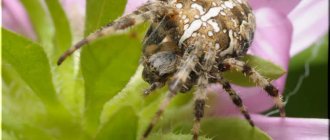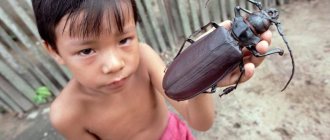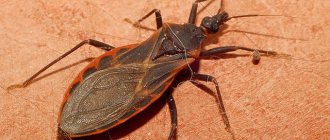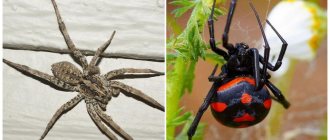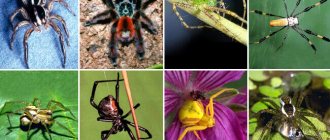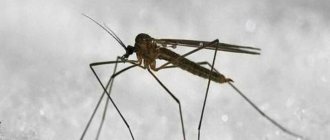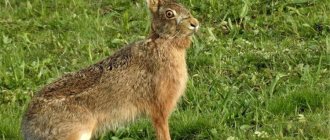Having a huge spider as a pet is certainly very impressive. Spiders are interesting to watch, and at the same time they do not make noise, do not litter, and do not chew shoes. Spiders do not need communication or tactile touch at all - the less you disturb them, the better they will feel. These are ideal pets for those who want to feel close to wildlife, but at the same time suffer from a catastrophic lack of free time. And, of course, spiders have a unique, vibrant and terrifying beauty.
It's no secret that despite all their advantages, spiders cause horror and disgust in most people. But most spiders are not dangerous and are even useful, because they destroy annoying small insects. By regulating the number of flies and midges, spiders help our ecosystem.
However, among them there are also very dangerous predators, whose bite can be fatal. In our selection you will see the most beautiful spiders in the world - among them there are both very poisonous and completely harmless.
Peacock spider
An incredibly beautiful creature. The abdomen of this colorful spider resembles a peacock's tail. Seeing a female, peacock spiders lift up and expand their abdomen, trying to attract her attention. As soon as the “girl of his dreams” approaches the male, he begins fiery dances, lifting his paws up and dynamically moving from side to side.
You can see this handsome man in the eastern part of Australia.
Karakurt / Latrodectus tredecimguttatus - up to 20 mm
A small inhabitant of the steppe, arid regions of the planet, it bites only in cases where it is disturbed and it senses danger.
A small spider with a characteristic color of dark dots grows no more than 10–20 mm, and males are even smaller, within 6–8 mm. Black spots may disappear with age, and then it becomes completely black. The species is very prolific, and every 10–12 years there is a significant increase in the karakurt population.
History has recorded bites of people, including on the territory of the Russian Federation. The bite is painful, and if anti-karakurt serum is not administered in time, the consequences can be tragic.
7
Metallic arboreal tarantula
The huge electric blue tarantula is rightfully considered one of the most beautiful spiders on the planet. It is often kept in home terrariums; many exotic lovers dream of getting such a miracle.
However, we would not recommend that you buy such a non-standard pet. The metal tree tarantula is very poisonous, and its bite can cause not only unbearable pain, but also lead to such unpleasant consequences as arrhythmia, tachycardia, disorientation, convulsions and tumors. No fatalities from the bite have ever been recorded.
5.Cyclocosmia truncata (Cyclocosmia spider)
It may not be the most beautiful spider in the world, but there is no doubt that it is one of the most unusual insects on the planet. On its belly there is a large flat growth, more like a real shield. The similarity is only enhanced by the fact that there is a beautiful pattern on it, more like the symbolism of some kind of cult. He is not protected by this growth in battle, as it might seem. In case of danger, the spider simply crawls into its hole, blocking the road with a kind of shield. This tactic allows him to withstand many dangers.
Martinique mahogany
Newborn Martinique mahogany spiders are dark blue with white stripes. However, as it matures, many red areas appear on it. Mature individuals have metallic green hairs - it seems that these beautiful spiders just love experimenting with coloring.
The sting of a Martinique mahogany tree feels the same as a wasp sting. They attack only in a desperate situation, when they feel a threat to their own life.
Reasons for appearance
The main habitat of insects is gardens, forests, orchards and trees. They build nests on plants and weave webs there.
The main reason why house spiders appear in residential areas is an abundance of suitable food. Adults are voracious, so they settle wherever there is a sufficient number of flies, cockroaches, mosquitoes and beetles.
Another factor that provokes the dispersal of creatures is suitable living conditions in terms of temperature and humidity.
Spiders love darkness, coolness and high humidity. In an apartment or house, insects settle behind radiators, on the back walls of furniture, and in the bathroom. Frequent destruction of the web forces predators to change their habitat.
More often, small animals can be seen in houses with damp foundations. Spiders do well in damp and dark rooms.
Creatures enter a person’s home through windows, doors, or the basement. People can bring an unwanted guest on clothes or with food (vegetables, fruits). If the home does not have conditions suitable for the insect, then it is unlikely to stay long.
Pamphobetus platioma
A huge spider whose paw span can reach twenty centimeters. This absolutely beautiful spider was included in our selection thanks to its soft, plush purple fur. However, only males have such an unusual color; females are content with a rather mediocre brown color.
These spiders are not suitable for keeping at home, because they absolutely cannot tolerate human touch - they immediately want to attack the one who dares to invade their personal space. If you try to pull the spider out of its hiding place, you cannot avoid a bite.
1.Poecilotheria metallica (Metallica spider)
This subspecies of tarantulas deservedly takes a leading place in the top 10 most beautiful spiders in the world. Their appearance combined with their small distribution makes them desirable specimens for almost every collector. The color is predominantly blue with a metallic sheen. Plus, each spider has an individual white pattern. This subspecies of tarantulas is very active, able to run fast and even jump. Combined with its aggressiveness and strong venom, this makes it dangerous to keep in the home, especially for inexperienced spider lovers.
Smiling spider
Yes, yes, the inventor of the smiley was nature itself. A smiling face seems to be painted on the abdomen of this cute spider. The smiling spider really looks very cute and positive.
This cute little guy is a native of Hawaii. It has a very modest size (body length - no more than 5 mm) and is not capable of causing any harm to humans.
Pholcus phalangioides - up to 9 mm
This species is distributed everywhere, but Europe is considered its historical homeland. In Russia it lives from the Far East to the coniferous forests of the Kaliningrad region.
Adults grow from 6 to 9 mm, and as usual, males are slightly smaller than females. It is painted in a light brown, almost cream color, but there is a gray pattern on the back. Like all representatives of harvesters, Volcus phalangoides has long legs.
It loves secluded dark places, so it lives in attics, basements, rock crevices, or abandoned tree hollows.
5
Spiny Spider
This cute spider has many names - spiny spider, horned spider, spiny orb spider. Along the edge of its wide abdomen there are six sharp horns, which should give the spider a threatening appearance and scare away natural enemies from it. The body length of this tiny spider does not exceed three millimeters - so it is unlikely that anyone is really afraid of it.
You can see this little miracle in the tropical and subtropical forests of the USA, Central America, South America, the Bahamas, Australia and the Philippines. Spiny spiders prefer to weave webs near swamps and streams.
8.Sicarius hahni (Six-eyed sand spider)
The power of this handsome man’s poison is in no way inferior to the Black Widow, and an antidote for it has never been invented. Fortunately, he does not seek meetings with humans and at the moment there is only one case of death from his bite. It got its name from its habit of hiding in the sand, from where it monitors the movements of potential victims. Meeting him for most insects means only death. The beautiful body of the sand spider looks like a small pancake with four pairs of legs.
Karakurt
One of the most dangerous spiders, which is also called the “steppe widow”. On the upper side of the black belly of the karakurt there are thirteen red spots - and this fatal number perfectly conveys the demonic character of this creature.
Karakurt does not attack on its own - only if it is disturbed. Those who have been bitten by the steppe widow have a hard time - unbearable burning pain spreads throughout the body, shortness of breath, tachycardia, disorientation, headache, nausea, increased sweating, hallucinations and delirium begin. Without immediate medical intervention, death is possible.
Be careful while on vacation in Crimea and the Azov region - steppe widows are found there quite often.
How the most beautiful children in the world have changed with age
Other people's children grow up quickly, and even more so if they are young actors and models. It is difficult for us to get used to the fact that famous girls and boys, who until recently were symbols of rosy-cheeked childhood, are already entering adolescence.
“Reedus” decided to show what children look like now, who a few years ago were called the most beautiful in the world. And one girl from the USA, whose baby photos are circulating on the Internet, is generally difficult to recognize!
Thylane Blondeau from France
French model and actress Thylane Blondeau was born into the family of a TV presenter and football player. The girl was amazingly beautiful, her plump lips a la Angelina Jolie gave her a special highlight.
It is not surprising that the baby, whom the media called the most beautiful child in the world, began her modeling career at the age of four.
And at the age of ten, her photographs appeared in a bold image in Vogue magazine, which caused a scandal.
https://youtube.com/watch?v=aDCEqaWcQrM
Tilan is now eighteen years old. She continues to gain popularity and tries her hand at cinema - in 2015, a film with her participation, “Belle and Sebastian: The Adventure Continues,” was released. 3 million people follow her Instagram page.
Tilan in childhood.
Thylane now.
Ira Brown from USA
American Ira Brown became a model even earlier. She was only about two years old when her parents brought her to a modeling agency. For the sake of beautiful photographs, she was given “adult” makeup, her hair was curled, and eyelashes were glued on, which caused criticism from some Internet users. Nevertheless, she was considered one of the highest paid female models.
Ira is now nine years old. Looking at her new photographs, it is difficult to recognize her - since the days of the “angelic” images, she has grown and changed a lot. Fans follow her photo shoots on Instagram.
Ira Brown in early childhood.
Ira Brown now.
Kristina Pimenova from Russia
The face of the young Russian woman Kristina Pimenova is familiar to many users of social networks, as her photographs often appear in various entertainment public pages.
The world media named the little model the most beautiful girl in the world when she was nine years old.
She managed to take part in Dolce&Gabbana shows, appear on the cover of the children's version of Vogue magazine, as well as in advertisements for Roberto Cavalli, Benetton and Kinder chocolate.
She is now thirteen and has around 2.5 million followers on Instagram. The daughter of football player Ruslan Pimenov has grown up a lot, but her facial features remain just as refined. Every day she receives more and more compliments from fans.
Kristina Pimenova in early childhood.
Kristina Pimenova now.
Anastasia Knyazeva from Russia
Another Russian woman, Nastya Knyazeva, was named by many publications as the most beautiful child in 2022, when she was six. The little girl from the Moscow region first appeared on the catwalk at the age of five, and then her parents signed a contract with the President Kids Management modeling agency.
Now Anastasia is eight years old. This year she became the host of the children's music program "Tyts Parade" on the STS Kids TV channel and an ambassador for the Street Beat Kids chain of clothing and footwear stores of world brands for children and teenagers. The girl’s mother runs an Instagram page on her behalf, which is followed by 1.4 million people.
Anastasia Knyazeva a couple of years ago.
Anastasia Knyazeva now.
William Franklin-Miller from Britain
London resident William Franklin-Miller woke up famous after a Japanese blogger published a photo of him and admired the child's appearance. The boy’s amazingly handsome face helped him immediately build a creative career - in 2013 he moved to Melbourne, where he works as an actor and model.
Now William is 15 years old, and his height is already about 180 cm. He has starred in nine films, among which “Arrow” and “Medici: Masters of Florence” are especially famous. The young man's growing up is followed by 1.4 million followers on Instagram.
William Franklin-Miller several years ago.
William Franklin-Miller now.
Brazilian white-knee tarantula
A very large spider with quite interesting coloring. The body length of an adult individual reaches nine centimeters, and the paw span can be up to twenty centimeters. Brazilian white-knee tarantulas can be quite aggressive, but due to their natural slowness and clumsiness, they are not considered dangerous.
Of course, this giant is poisonous, but its poison cannot pose any danger to humans. The most unpleasant thing that can happen to you after contact with a Brazilian white-knee tarantula is irritation and itching.
These spiders are often purchased by lovers of exotic pets, and can live in captivity for up to fifteen years - the care of their owners benefits them.
Spider outside and inside
Spider horror films often follow one of two storylines. A person or group of people become victims of countless hordes of spiders that arrived from exotic countries, from outer space or mutated under the influence of external factors. Or the person himself turns into it after a fatal bite. All these scenes are accompanied by inhuman suffering and are surprisingly believable, which is why horror films about spiders are becoming increasingly popular.
Events can develop in caves, old houses, on glaciers and even in space. Spiders can attack entire cities, growing to incredible sizes. There is also an opinion that it is people who live in the kingdom of spiders, and not vice versa, because their population arose much earlier than the human population.
Argiope Brünnich
People call these beautiful creatures “wasp spiders.” These are medium-sized spiders - the body length can slightly exceed three centimeters in females. Males of Argiope Brünnich are very small - about five millimeters.
Females of this species are easy to recognize due to their outstanding external characteristics - a striped yellow-black abdomen and very long legs. But the males are completely unremarkable - black or gray.
2.Maratus volans (Peacock spider)
But it will be very difficult to see the peacock spider with the naked eye. Still, the size of an adult does not exceed five millimeters. This species got its name about a hundred years ago. On its body there is a special shield with a very bright pattern, different for different individuals. This part of the body is used by males only to attract individuals of the opposite sex during the mating season. With the help of various dance-like movements, the spider attracts attention. This behavior, combined with a pattern similar to a peacock’s tail, determined its name. Many believe that this particular species deserves the title of the most beautiful spider in the world .
Maratus personatus
This is probably the cutest spider on the planet. We're willing to bet that these amazing creatures can make even the most ardent arachnophobe smile.
These furry babies do not grow more than five millimeters. But small sizes and non-standard colors are not all of their advantages.
The most beautiful thing about these spiders is the way the males court the females. They perform amazing dances, lifting their paws up - believe me, it looks very funny.
How dangerous are spiders to humans?
Don't you think that a person can die even from the slightest touch of these terrible spiders? In fact, everything is not as scary as it seems. Firstly, wolf spiders do not attack people unless provoked. Secondly, this type of spider is not poisonous and a bite can hardly lead to the death of a person.
The maximum that a person feels after a spider bite is a slight pain and itching. Despite this, it is better to be wary of tropical wolf spiders because they bite much more painfully, and the consequences include swelling, dizziness and nausea
If such a problem happens to someone, it is important to consult a doctor
Eresus
These are very small spiders - their body length is rarely more than one centimeter. Eresus males have a red-orange abdomen with black spots, and females, alas, do not have an unusual color. Males often have white rings on their legs.
Eresus dig deep holes underground, in which they set up their own home. They hunt flies, butterflies, and beetles.
The bite of these spiders is very toxic and can even be fatal. Unfortunately, these beautiful but dangerous spiders are quite common in our country.
Arachnids
The arid regions of Central Asia and Africa are home to large arthropods that are often mistaken for spiders. These are salpugs. According to the English translation, they are also called camel spiders. But unlike spiders, salpugs have teeth, they do not have arachnoid glands and are not poisonous.
Solpuga
Salpuga is a large animal capable of catching up and killing not only invertebrates, but also small lizards. The chelicerae of large salpugs are so powerful that they can bite through a human fingernail. No real spider is capable of this. Although salpugs do not have poison, their bite can be very dangerous. Particles of decaying flesh remain on the chelicerae of these arthropods. After a bite you can get blood poisoning.
Spiders cause arachnophobia in many people, although they are one of the most harmless and useful inhabitants of the planet. Spider lovers consider them “kittens.”
Maevia inclemens
These are small spiders that live in Canada and the USA. They made it into our selection due to their huge eyes, which make them look like cartoon characters.
The body length of females is up to eight millimeters, males – up to seven millimeters. The abdomen is beige, with sparse orange hairs and black stripes. There are males with a black body.
Muscular racer / Hyllus diardi - up to 13 mm
The habitat of this species of horse, named after the mythological hero Hercules, is Southeast Asia. Despite the name Hercules, they grow no more than 1.3 cm.
It differs from other representatives of the genus in that it does not weave webs. The muscular jumper hunts insects, hiding in the foliage, and when it sees the prey, it jumps and hits it.
He has excellent vision and an eye, accurately calculating the distance to jump. Males are saved from cannibalism by the fact that they are slightly larger than females.
Goliath tarantula
One of the largest spiders on the planet. Twenty years ago, a goliath tarantula was caught in Venezuela with a paw span of twenty-eight centimeters.
These huge spiders can be seen in the rainforests of Brazil and Venezuela. Goliath tarantulas live in deep burrows and only go out hunting at night. These spiders have an aggressive, nervous nature, and do not like human touch too much.
Redback Steed
The red-backed jumping spider prefers to live in relatively dry areas and is often found on coastal dunes or oak forests in North America, where it is one of the largest jumping spiders. A special feature of this species is the ability to build tubular-type silk nests under stones, wood and on the surface of vines.
North American black widow
A poisonous spider that can be seen in North America, Australia and Oceania. The color is, as the name suggests, black. You can often see an hourglass-shaped mark on the abdomen. Females that have not reached adulthood have a white outline around the red spots.
After copulation, the females of this species eat the males. The bites of this spider are extremely toxic and can be fatal even after taking an antidote.
Nephila clavipes
The name clavipes was given to the species by Carl Linnaeus in 1767, it comes from the Latin. clava - “thick stick”; and pes - “foot”, “paw”
Next on the list is the Nephila Clavipes spider, with a bright pattern on its abdomen and colorful long legs. It is also known as the golden silk spider. Found in wooded areas of South and North America.
Females of the species Nephila clavips differ noticeably from males in size. The span of their legs reaches 12 cm with a body length of 4 cm. Males are 5 times smaller and 70 times lighter. By studying the DNA of nephiles, scientists found that females gradually increased in size during the process of evolution, while males remained the same as before in the Paleozoic.
The web of an adult female can reach 2 meters in diameter, not counting the anchor threads up to 3 meters long that secure the web between the trees. It is strong enough to hold a small snake, bird or bat. The yellow pigment in Nephila clavips silk gives the web a golden sheen, which is especially visible in the sun.
Nephiles often suffer from spiders of the genus Argyrodes, which steal food from them, and a dozen small parasites can even survive the orb weaver. He will have to leave his old networks and weave new ones.
Mirror Spider
An amazingly beautiful work of nature. This little spider looks like an iridescent gem. Its abdomen is covered with small mirror plates. Mirror spiders are very small, they do not grow more than four millimeters. Surprisingly, the size of the mirror plates depends on the emotional state of the spider.
This miracle lives in the eucalyptus forests of Australia and Singapore.
6.Phidippus audax (Jumping spider)
This spider is harmless to humans. The appearance of his body is very beautiful, it combines various colors of blue, orange and light green shades. Among the numerous patterns, there are also those that resemble emoticons. Despite its miniature body size, the Jumping Spider can easily give a person a heart attack, even if he is not an arachnophobe. It's all about his ability to jump almost half a meter. This feature will definitely not leave anyone indifferent, especially if you don’t expect such agility from a spider.
Himalayan racer / Euophrys omnisuperstes - up to 6 mm
This unusual species was discovered on Mount Everest, so among arachnids it is the highest representative of the spider world on Earth. This is what the scientific name of the species tells us, which means “living above all.”
The extreme point where the climbers met the Himalayan horse was at 6,700 m. This is a very tiny spider, the female of which grows up to 6 mm, and the male no more than 4–5 mm. It feeds on small flies, and scientists have not found any changes in the body that have adapted it to altitude. The structure is the same as most jumping spiders.
It was first discovered back in 1922, but only in 1924 the species was described and qualified in the scientific world.
1
Spiders have a bad reputation in the animal kingdom, often described as “creepy,” “scary,” and even “nasty.” Six percent of us are so obsessively afraid of our eight-legged friends that this fear has been dubbed a phobia, arachnophobia. The rest of us endure them. Their image is not helped by hairy legs, multiple eyes and oozing venomous fangs. That's why they are an integral part of horror movies and Halloween decor.
But there are spiders that are amazingly pleasing to the eye. And their beauty is truly difficult to dispute.
10. Sparkling muffin or Sparklemuffin (lat. Maratus jactatus)
Like most peacock spiders, Maratus jactatus performs an elaborate courtship dance. Later we will see another peacock spider. In 2014, Madeleine Girard, a graduate student at the University of California, Berkeley, discovered this new species in southeast Queensland, Australia. Girard lovingly nicknamed him "Sparklemuffin."
Sparklemuffin has a blue and red iridescent belly that he raises like a colorful fan to attract Miss Sparklemuffin's attention. When he's not raising his paw, he uses it and his seven other appendages to rhythmically tap out a message to his potential mate. Imagine fanning and tap dancing to the cancan. Luckily for him, his girlfriend has eight eyes, giving her a wide angle of view of this dance, as well as the ability to see movement. Unfortunately for him, if his girlfriend doesn't like what she sees, she'll eat him. Only four of her eyes look forward, the rest give a new view, since the rest of the eyes are behind and to the side. These eyes can also see a much wider spectrum of light than the human eye.
Sparklemuffin is only 4mm (1/6 inch) in size and can fit comfortably on your pinky fingernail.
9. Brazilian crab spider (lat. Epicadus heterogaster)
Epicadus heterogaster is a member of the crab spider family, so named because its front legs are longer and curve forward rather than down, giving them a crab-like appearance. They can also “crab-walk” sideways and backwards. Crab spiders do not spin webs, but wait until insects get close enough to ambush them.
Epicadus heterogaster does this in two ways. Smaller juveniles camouflage themselves by perching on flowers that match their color - white, yellow or purple. It also has a protrusion on its abdomen that can be mistaken for flower petals. Even his slow, sharp movements are more like leaves swaying in the wind.
An adult Epicadus heterogaster can also lure insects whose body color reflects ultraviolet light. Scientists discovered this when they applied sunscreen to a female's back and watched as the insects ignored it. They're not sure why pollinating insects are attracted to reflective ultraviolet light, but it's possible that the light mimics UV color patterns and natural bright spots.
8. Metallic tree tarantula or ultramarine tarantula (lat. Poecilotheria metallica)
First classified in 1899 as Poecilotheria metallica after it was discovered at the Guthi railway station in south-central India, this tarantula has virtually disappeared within 102 years. Rediscovered in 2001 on a small forested area of 100 square meters. km in the Indian districts of Kadapa and Chittoor in the Andhra Padesh state, it has quickly become a prized pet for tarantula lovers. Which is both unfortunate and fortunate for this beautiful spider. The Andhra Padesh forest is rapidly degrading due to logging and human encroachment, resulting in the spider being listed as a "critically endangered" species. To make matters worse, years after it was rediscovered, poachers were catching these tarantulas to sell. It is currently illegal to remove the ultramarine tarantula from its natural habitat, but it is legal to purchase domesticated spiders and breed them. Their popularity in Europe and the US may give the species new hope.
In the wild, these spiders build funnel-shaped webs in tree holes and wait to ambush any insect that comes close. They then bite their prey with their venomous three-inch fangs. This means that only experienced arachnologists should take the ultramarine tarantula as a pet. They are aggressive and very fast. Although their venom is not usually lethal to humans, their bite is painful and can cause headaches and increased heart rate for up to a week.
The spider's rich blues and yellows have less to do with the actual coloring and more to do with tiny nanostructures on the tarantula's hair that flex and reflect blue and yellow light. This means that the ultramarine tarantula will appear a different color depending on the viewing angle, a trait known as iridescence. Peacocks and dragonflies also have this trait.
7. Sequin or mirror spider (lat. Thwaitesia nigronodosa)
Photo. Mirror spider (lat. Thwaitesia nigronodosa)
Another native to Australia, Thwaitesia nigronodosa lives in the rainforests of Queensland. Like most members of the Thwaitesia genus, it has been given the nicknames Sequined Spider or Mirror Spider, a reference to its disco ball-shaped butt. Its skin is filled with specialized cells called guanocytes, a crystallized version of the digestive waste product guanine that is normally excreted from the spider's body. Guanine reflects light, making it silvery, like a mirror, and the articulated cells form a kind of mosaic. This shiny case is especially useful when you're hiding among the rainforest foliage.
The mirror spider has another defense mechanism: if it is disturbed or must quickly fall out of its web, it can immediately hide the guanocyte cells, changing its appearance to a dull hue, like dirty earth. How it does this is not very clear, but it is believed that it contracts muscles covered with guanocytes. In short, the buttock shrinks.
6. Elegant golden jumping spider (lat. Chrysilla Lauta)
We have known about the beautiful Chrysilla Lauta for over 130 years, but it is so rare and so tiny (just a few millimeters) that little is known about it. We don't know whether its beautiful iridescent coloring is intended for camouflage or to attract the attention of a mate. We're not even entirely sure what the female of this species looks like.
What we do know is that Chrysilla Lauta is a member of the jumping spider family, and several videos show this little guy jumping long distances. There are more than 5,000 species of jumping spiders, accounting for about 13 percent of all spider species. Although they have no muscles in their legs, they can long jump up to 50 times their own size using hydraulic propulsion. Their hairy legs also give them traction on almost any terrain, including glass. Such terrain is usually found in the jungles of China, Burma and Vietnam.
5. Eight-spotted crab spider (lat. Platythomisus octomaculatus)
Platythomisus octomaculatus is one of the largest crab spiders in the world, measuring up to 7.6 cm. Despite this, they are relatively elusive in the wilds of Southeast Asia, stretching from India to Burma and Singapore.
If the name "eight-spot" is confusing after counting spider spots, you're not alone. When German arachnologist Karl Koch named the species Octomaculatus (octo, meaning eight) in 1845, no one seemed to know what spots he was counting. Drawings of its species indicate four pairs of spots on the abdomen, rather than the three pairs plus an elongated stripe we see today. What's even more confusing is that the number of spots on this spider's dorsal abdomen changes as it grows. The cubs only have two, and as they age they develop more spots, not only on the top of their abdomen, but also one large one underneath. It also grows six on the front part known as the carapace, including so-called "panda spots" around its eyes. To make matters worse, the size of the spots on an adult female changes significantly after laying eggs. The confusion has led to the misidentification of many other species with similar spots.
4. Triangular spider (lat. Arkys lancearius)
We've long known that horseshoe crabs aren't crabs at all, but it wasn't until 2019 that scientists analyzed their DNA and discovered that they are actually distantly related to spiders and scorpions.
If you compare the appearance of spiders and crabs, you can easily believe that they are related. They are both arthropods, with skeletons on the outside (i.e. exoskeletons), and both have jointed limbs. And Arkys lancearius, a member of the spider crab family, has a coloration and abdomen shape similar to its crustacean namesake. Even his paws are crab-like. That is until you count the number of legs: arachnids have eight, crustaceans have ten or more. And when we look at the insides of crabs and spiders, we clearly see that they are not really related.
Like horseshoe crabs, triangle spiders defy classification. Since it was first described in 1837, Arkys lancearius has been placed in several different families, and debate continues to this day. They are common in warmer areas of Australia and New Zealand and come in shades of red, yellow, orange, brown, black and white. They hunt from ambush, using the web as a safety line rather than as a trap for prey.
3. Long-horned spider (lat. Macracantha arcuata)
Photo. Long-horned spider (lat. Macracantha arcuata)
Of the 35,000 species of spiders, half form webs to catch prey. Perhaps the most recognizable nets are the radial mesh nets, made up of concentric circles and held together by knitting needles. Most of these creations are the work of orb-weaving spiders (Araneidae). The term "ball" can be confusing because it comes from an old English word for a two-dimensional circle, rather than the modern three-dimensional sphere. With more than 3,000 species, the family Araneidae is the third largest among spiders and the most diverse in size and appearance.
As if to prove it, the female Macracantha arcuata has an impressive pair of antenna-like horns on her abdomen. But these horns are not designed to catch any melodies, but, it is believed, to make it more frightening to predators. These bellies can be red, white, black or yellow, and females are often about a centimeter in size. The male is usually ten times smaller, making him about the size of a post-coital snack for the female. Macracantha arcuata is another jungle native of Southeast Asia, but due to an accidental introduction, it can now be found in the southeastern United States.
2. Cat-faced spider (lat. Araneus gemmoides)
Another weaver spider, Araneus gemmoides, has been named the cat-faced spider because of the pair of horns on its abdomen that resemble cat ears. Behind the horns are eye-like dimples with grooves on the sides, similar to the tabby cheeks of a tabby cat. To complete the picture, the abdomen is covered with tiny, fine hairs. Araneus gemmoides comes in a variety of colors from pale yellow to dark grey-brown.
The cat-faced spider is quite common in the western United States, with its home extending from Alaska to California and even east to Colorado. Both sexes have bulbous butts, but the female's gets even more bulbous after she mates (and eats) her lover. Before the winter frosts, the mother dies, leaving a large pouch. In the spring, the eight-legged babies snack on each other, then lift silk threads to catch the breeze and carry them to another place. The venom of Araneus gemmoides is not dangerous to humans, and its fangs cannot pierce the skin. But these fangs can strongly pinch the back of your hand.
1. Maratos Madeline (lat. Maratus Madelineae)
Maratus Madelineae did not need a flashy name like its fellow peacock spider Sparklemuffin, but the story behind its species name illustrates the explosion of interest in peacock spiders over the past decade.
The peacock spider (genus Maratus) was first described back in 1874, with its beautiful iridescent belly wings mistaken for wings. Although this tiny spider was quite common in Australia, little research has been done for over 130 years, with only five species identified in that time. That all changed in 2005 when Australian Department of Agriculture tick expert Jurgen Otto noticed a brownish speck bouncing around his legs while walking in the woods. Otto was an entomologist who worked on six-legged insects and had never heard of a peacock spider, so he took it to Julianne Waldock, an arachnologist at the Western Australian Museum. Waldock had spent the previous decade studying Maratus, and it was she who believed that the little guy was dancing, and raising his colors not to fly, but to get a dance partner.
Otto was fascinated by filling his house with 300 captured peacock spiders. Otto was also an avid photographer, and his photographs caught the attention of South Carolina jumping spider expert David Hill. In 2011, Otto used a macro lens to capture a peacock spider dancing and created a YouTube video featuring the Bee Gee's Staying Alive soundtrack and photoshopped maracas. The video received 7.5 million views. People couldn't get enough of this cute little guy.
That same year, Otto and Hill described and named their first new species of Maratus. Over the next eight years they will produce 46 more titles. Waldock will name nine. In fact, Otto's YouTube video inspired amateur scientists and photographers to travel to Australia in search of the tiny dancers. For example, Maratus Harrisi was named after amateur photographer Stuart Harris, who simply posted a photo of a peacock spider on Flickr only to find out that it was an undiscovered species. Otto also has a peacock spider named after him (Maratus Ottoi), as does Waldock (Maratus Julianneae). And Maratus Madelineae is named after Madeleine Girard, who gave the name to Sparklemuffin. A total of 71 species of peacock spiders were discovered and named from 2011 to 2022.
When Maratus Madelineae dances, it doesn't just lift its leg like its cousin Sparklemuffin, but lifts its two appendages above its head, swinging them around like it doesn't care. And sometimes he brings them together, as if clapping his hands. Just below its eyes and covering what would be our mouth is a pair of secondary legs known as pedipalps or simply palps. On Maratus Madelineae, the tentacles are white and hairy, similar to an old man's beard. And when he dances, he swings those tentacles rhythmically, like an old man chewing on his dentures. In his video, he looks a little like Grandpa trying to do the Hokey Pokey.
This entry was published on Tuesday, January 12, 2022 - 1:01 pm. You can leave a comment.
How to get rid of house spiders in the apartment and in the house
The main thing is to do the right thing without harming pets. Since house spiders do not infest a house or apartment en masse, they are easier to deal with than bedbugs, cockroaches and other vermin.
- Destroy identified arthropods.
- Sweep away the cobwebs or vacuum them up and take them outside.
- Find, collect and destroy cocoons with eggs.
- Seal up places where spiders enter the apartment.
- Carry out thorough cleaning regularly.
Spiders do not like the smell of mint, chestnut, eucalyptus, orange and hazelnut. They also don't like the smell of vinegar.

